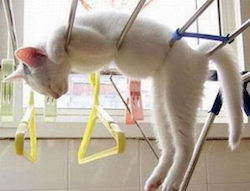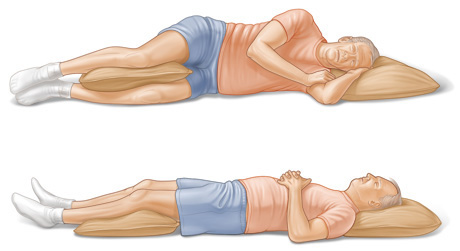
Not a recommended sleeping position for humans.
Sleep is hugely important. Like it or not, you spend a ton of your life in bed.
So use that time to make your body better – instead of making it worse.
When people come to me with chronic mobility/flexibility/myofascial pain issues, sleeping position is often the first thing I inquire about.
Why? Because improper sleeping posture is horribly common, and it has negative implications all over your body.
In constructing optimal sleep position, we’ll consider the health of your:
- Spine (especially neck)
- Shoulders
- Hips
Here’s What Most People Are Doing Wrong

When laying on your back, do you feel the need to push one knee out to the side in a “figure 4” position? That’s your hips screaming for support – begging to be open.
Sleeping on your stomach is a bad idea, period. It’s guaranteed bad for your neck, shoulders, and hips. It’s an unsalvageable position. Just don’t ever do it.
Side sleepers are often lacking support for their cervical spine (fancy term for neck), upper shoulder, and hips. Attempting to compensate for the nonexistent neck support often results in problems for the lower shoulder as well.
Back sleepers also tend to miss out on neck support, resulting in the head tilting back, and the shoulders rolling forward – causing problems there too.
Another huge issue is lack of support for allowing open hips. See the picture at left for how your body tries to compensate.
Optimal Sleeping Position – Back
Try no pillow at all under your head. Your cervical spine (that’s your neck) has a natural curve that supports it well while laying on your back.
Put another pillow under your knees. This will force them up a bit, preventing over extension of your hips without you having to externally rotate them like crazy to open them up. This will reduce tightness in your hips and flutes, lessening back and leg pain.
Put a final pillow on your chest/stomach, for your arms to rest on. This will prevent the load of your arms from torquing your spine into an s-shape, which can cause shoulder, back, and neck problems.

If he added a pillow to support his arms in both positions (especially on the side – that arms near face thing is bad news), and ditched the pillow under his head while on his back, this guy would have it figured out.
Optimal Sleeping Position – Side
You need to support your neck. Roll up a towel and put it inside your pillow case, along one long edge. Put that edge under your neck. You may need a second pillow to keep your head from tilting too far. This will reduce neck, shoulder, and upper back pain.

This is what you’re trying to accomplish with the towel trick. Her neck is supported and her head is in line with her spine.
Put a pillow between your knees. This will prevent your top knee from dropping down in front of your bottom knee, an extremely internally rotated position that causes lower back and leg pain.
Put a pillow up against your chest, like you’re spooning it. The support it provides for your upper arm will prevent your shoulder from rolling forward, loading your back unnaturally.
For these same recommendations in video form, watch Kelly Starret’s Fantastic Videos (1,2,3).
When you sleep in the right position(s), your sleep will actually be the restorative process it needs to be for your health. You’ll get better rest and wake up pain free. Well worth the cost of an extra pillow or two.
Note: posture is not the only thing you have to think about for optimal sleep. Light is hugely important too. (1,2)
Do you have any experience with pain from sleeping, or any tips for good sleeping posture? Share in the comments!





I was thinking “Kelly Starrett” the whole way through this article. Yeah, I’ve watched all of his videos on sleeping positions, and done my best to incorporate them into my night. This is not as easy as one may assume. At first I kept finding myself in bad positions, but over time, resetting and going back to sleep, I have improved about 80%. I still need a better pillow. We should all sleep on the best setup for our body. Save money on other things so you can spend it on your sleeping situation. So worth it.
Thank you. Informative n nice n short. I have a 16 yr old boy with c.p. n he gets his neck into terrible over extension when sleeping. He sleeps on his back using a basic sleep system with laterals for his sides n hips with a pillow under his legs. Is there something to use to help prevent this from occurring?
I just happened to see this – and I’m not an expert, but I’ll share my personal experience – if your son’s neck pushes forward while he’s sleeping it may be because he has a narrow airway. You know how when you learn CPR, the first thing they say is to lift the chin to help open the airway? That’s what his body might be doing. It’s what my body does. I have had a head-forward posture most of my life and have been told (often scolded) by physical therapists about my “poor posture” since I was a teenager. I wake up in the night and wonder why my head is pushed so far forward that it’s hurting me.
Now, I’m almost 50 and I’m finally learning that my body was pushing my head forward (in essence, lifting my chin, but then my eyes naturally train to the horizon, resulting in the head forward posture). This was strictly for survival purposes. During waking and sleeping hours. No amount of exercising or strengthening is going to improve my posture until my airway is addressed. I’ve now had a sleep study, I’m working with a myofunctional therapist, a DO, a dentist, orthodontist, and a surgeon. I hope that this might help your son!
I have pericarditis for one year & 2 months. This prevents me from laying flat &. I have been sleeping in a sitting up position with 3 pillows all this time. I have developed pain in my left hip joint & now my right one is starting. Its like they are freezing up & I cant walk properly from the pain. What is happening to me & is it serious?
I sleep mostly on my left side with the blanket (comforter) tucked between my knees and my ankle bones rub together so I need to put part of the blanket between my ankles as well. With warmer weather and lighter blankets my ankles have become sore, right ankle bone jabbing the inside of my left heel. I tried moving my legs apart a little but this put stress on my hips, so I have to keep my feet together and put a pillow or something thicker between my ankles.
Your question about pain from sleeping struck a chord. I have piriformis syndrome and have to get up two or three times a night to lie in the floor get in a half sitting position and press the muscle between bone and floor until the muscle relaxes.
It takes about an hour and a half each morning to get the piriformis muscle to relax enough that it isn’t pinching the sciatic nerve so much that sitting, standing and walking are painful.
During the day, i can find ways to stretch the piriformis and keep the pain at bay.
But the longer i stay in bed between the sessions in the floor, the more the sciatic nerve gets pinched.
We bought a super firm mattress (i asked for something comparable in firmness to a carpeted floor), try to sleep with a pillow between my knees, my employer got me a standing desk this week, and i have an ergonomic mat for it. They all seem to be helping some, but what seems to cause the most pain is being in bed for more than two hours at a stretch.
I am a side/stomach sleeper, I sleep with pillow under/between my legs and two pillows for hugging and support lol. What I don’t get is I keep waking up with my legs in an exaggerated 4 position, bent leg over straight leg, foot flexed, hands next to my head on each side. And not until recently I noticed this because my mom told my doctor how I slept in this same weird position since I was little. What I wanna know is why do I keep waking up in this same position? Is it a bad habit?